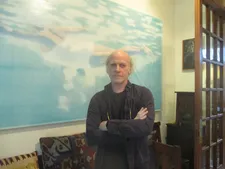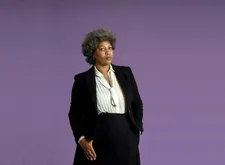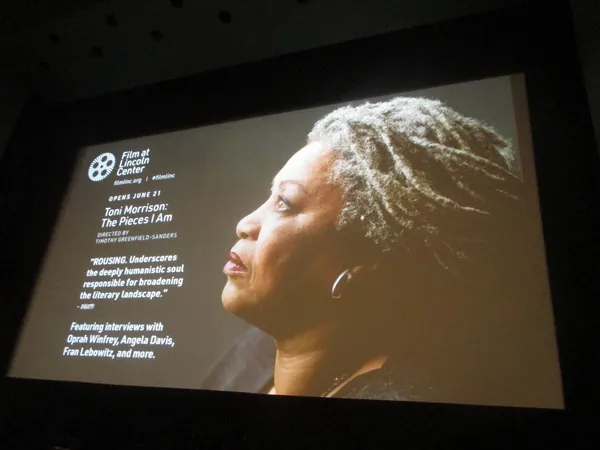 |
| Timothy Greenfield-Sanders on direct-to-camera for Toni Morrison: The Pieces I Am: "It really conveys how much Toni is controlling the narrative." Photo: Anne-Katrin Titze |
In the first instalment of my conversation with photographer Timothy Greenfield-Sanders, director of Lou Reed: Rock And Roll Heart and Toni Morrison: The Pieces I Am, which took place on the day we heard that Sylvia Miles died, Timothy goes into the direct-to-camera of Shirley Clarke, Andy Warhol's Screen Tests, Warren Beatty's "slightly off camera" Reds, and Errol Morris. Raoul Peck's brilliant I Am Not Your Negro on James Baldwin, Kirk Simon's The Pulitzer At 100, Joanna Hogg's The Souvenir, being seated where Toni Morrison sat for The Black List, and what's in a gaze came up.
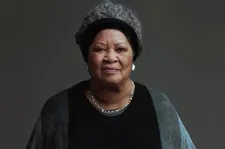 |
| Timothy Greenfield-Sanders on Toni Morrison: "I felt it was my portraiture coming to life." Photo: Timothy Greenfield-Sanders |
Toni Morrison: The Pieces I Am contains a plethora of components radiating light on the Nobel and Pulitzer Prize-winning author's fascinating life. Much of Toni Morrison's work concerns the gaze and Timothy Greenfield-Sanders, master of the portrait and longtime friend of the documentary's subject, put to use a unique way to formally address the issue. While the interviews are direct-to-camera with Morrison, the others, including Oprah Winfrey, Fran Lebowitz, Walter Mosley, Sonia Sanchez, Farah Griffin, Hilton Als, Russell Banks and Angela Davis are not, a nod to the fact that as close as you may be to a person, your perspective of another is always slightly askew.
The US Postal Service on June 12 issued a new commemorative Forever stamp saluting former President George HW Bush, that is based on a photograph taken by Timothy Greenfield-Sanders in 1997. He is also a proud owner of a New York Public Library card Celebrating Lou Reed.
Anne-Katrin Titze: Lou Reed and Toni Morrison - is there anything that would surprise us the two had in common?
Timothy Greenfield-Sanders: Yes, I think they have a lot in common. I think both are incredibly creative on a world-class level. Surprisingly, Toni also has a real sense of music. There's a musicality to her language.
AKT: You could have exchanged the subtitles of your films: Toni Morrison: Rock and Roll Heart and Lou Reed: The Pieces I Am.
TGS: They're interchangeable! I never thought of that. That's very funny. It's very funny, my grandson, who is nine, who saw the film, he wanted to call it Words Have Power. Because of that wonderful line in the beginning. It's so interesting that a nine-year-old would absorb that. He's very smart, but still.
AKT: How a turn of phrase can change you.
TGS: Grasp you.
AKT: And you never forget it. There are certainly those in Toni Morrison's work. Are there certain phrases for you that have this power?
TGS: I think that there are certain people, and I'm not one of them because I'm a visual person not a writer, and I am jealous of that ability to create a kind of - soundbite is a terrible word for it - very smart, insightful, meaningful statement so precisely. And again, interestingly, that's what Lou was able to do. Lou always talked about condensing his language into songs and that every word had a lot of meaning to it. And I think that Toni is just a master of that as well.
AKT: The 'white gaze' for example, is something that many white people never thought about before reading it and being confronted with it.
TGS: Right.
AKT: Whatever you take for granted.
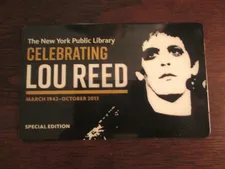 |
| Ed Bahlman's Lou Reed New York Public Library card Photo: Anne-Katrin Titze |
TGS: The white gaze is also in film theory, oddly enough.
AKT: Yes of course, like the male gaze.
TGS: That's right. And Toni was able to kind of take that phrase that has so much meaning and is so simple. The white male gaze says everything. The - White - Male - Gaze - four words, you know. That's very powerful.
AKT: The one that isn't questioned, where the perspective isn't questioned.
TGS: And The Master Narrative was the other one that I thought was so beautiful in that section of the film with Bill Moyers. Where he is kind of trying to understand what she is talking about. She is talking about how every point of view that you see as a person has this narrative that is speaking to you. That a white doll is meaningful, not a black doll. Everything you have has meaning. That's the master narrative.
AKT: Great choice of clip, by the way, Bill Moyers looking puzzled. He repeats it, doesn't know what she means.
TGS: He is trying to understand it.
AKT: In the beginning of your film when she [Toni Morrison] is talking about her grandfather reading the bible and then the comment "but it was illegal." To read. The bible. It's shocking, even for people who consider themselves halfway informed.
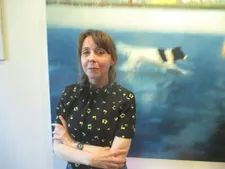 |
| Timothy Greenfield-Sanders shoots Anne-Katrin Titze in front of a painting by Isca Greenfield-Sanders Photo: Timothy Greenfield-Sanders |
TGS: I think that the history of racism in America is so profound and so misunderstood. When you have these politicians saying things like they do and to contrast it with this kind of thing. It was illegal to be able to read or to be taught to read!
AKT: Of course you have seen the James Baldwin, I Am Not Your Negro film [by Raoul Peck]?
TGS: Yeah, fabulous.
AKT: A fabulous film that takes you and shakes you.
TGS: I think we wanted to do that here and we wanted to also show this very remarkable life. Toni's not just the editor at Random House, she's not just the single mother of two kids, she's an important professor.
AKT: At Princeton.
TGS: Who created the Atelier in Princeton which is a very special arrangement where students have to take classes with fine art artists to kind of broaden their perspective. And that was Toni's idea. And then of course, Toni, the writer.
AKT: Her advice to students is "Don't write what you know!"
TGS: I love that.
AKT: To write as far from your life as you can, is the opposite you'd think. When I saw your film, I had just watched Joanna Hogg's The Souvenir. Have you seen it?
TGS: No, I haven't seen it.
AKT: It's wonderful. In the film the autobiographical protagonist is constantly bombarded with instructors telling her: "Do what you know, do what you know!" And there is Toni Morrison saying the opposite.
TGS: Don't do what you know! You don't know anything!
AKT: Exactly! The looking into the camera and the not-looking into the camera decision ...
TGS: Right. When you start a film you think about how to and what the look is. Particularly for me because I'm a photographer and I have a very distinct style as a photographer, which I used for The List Films to create that look. The direct-to-camera portraiture starting in 2008 when Errol Morris was using it and maybe one or two other people had played with it. That was my … and I'm not taking credit for being the first, I'm not.
AKT: I mean, it's a bit like the Andy Warhol Screen Tests.
TGS: It is. Which is my influence. Very, very smart of you. I'm very impressed. Shirley Clarke was the first to do it, if you really look back at filmmakers, Shirley Clarke did these direct-to-camera interviews. You look at Reds, long before anyone was doing it. Shirley was first, but Reds, Warren Beatty, he did it. It's slightly off camera, it's a little bit misleading, it's not really direct-to-camera. I created it for The List Films because I felt it was my portraiture coming to life. It was my single light source, the clean backdrop, direct camera gaze.
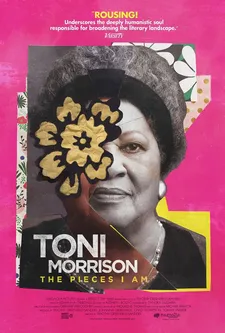 |
| Toni Morrison: The Pieces I Am poster - opens at Film at Lincoln Center and the IFC Center on June 21 |
AKT: You're rolling your eyes with the word gaze.
TGS: Because it's a charged word.
AKT: And we just talked about all the gazes.
TGS: But it was very powerful and when i first did it, Toni was the first, you know, to sit for The Black List. It was an inspiration from Toni that I did that film in that style. At this table. She was sitting right here. You're sitting where Toni Morrison sat. What I wanted to do here I was thinking at the beginning of the film: Is this over the shoulder camera interviews? Is this direct-to-camera with everyone? What are we going to do? And I had never seen a film where you combine them.
AKT: True.
TGS: Where the main subject tells her story right to you. And everyone else talks about her off camera like that and would that work. I think it's genius. I can't say that. I think it's very effective.
AKT: You can say it yourself.
TGS: If I can say it myself, I think it's genius. But it was risky. Because once you go down the road of doing it ...
AKT: … you have to do it this way with everyone?
TGS: You're stuck with it. I was confident it would work. An added advantage to it is that it makes it feel that Toni's telling her story. I'm not telling her story. Toni's talking to you, the audience. And that's a very important thing as a white male film director talking about a black woman of such importance. It takes me out of it somewhat as well. I don't think I was conscious of that in the beginning. As I started to see it come together, I felt, you know, that's really working very well, because it really conveys how much Toni is controlling the narrative. Am I talking too much?
AKT: Absolutely not. And praising yourself is also like Toni Morrison in Kirk Simon's film The Pulitzer at 100. I don't know if you've seen it?
TGS: I haven't seen it, no.
AKT: He has a clip of Toni Morrison saying "I was deeply, deeply impressed." And we see her leafing through Beloved, commenting on re-reading her own book. That's her sense of humour.
TGS: That's marvellous, I love that. That's probably Chloe Wofford [her birth name] versus Toni Morrison. So Chloe Wofford was reading Toni Morrison, being impressed.
Toni Morrison: The Pieces I Am opens in the US on June 21.








